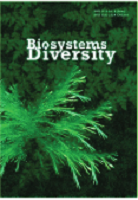Impact of climate change on potential distribution of Quercus suber in the conditions of North Africa
Impact of climate change on potential distribution of Quercus suber in the conditions of North Africa
Author(s): A. Benabou, S. Moukrim, S. Lahssini, K. Menzou, M. Elmalki, M. El Madihi, L. RhaziSubject(s): Energy and Environmental Studies, Environmental Geography, Environmental and Energy policy, Environmental interactions
Published by: Дніпропетровський національний університет імені Олеся Гончара
Keywords: Cork oak; habitat suitability; MaxEnt; modelling species distribution; Morocco;
Summary/Abstract: Climate change, which is expected to continue in the future, is increasingly becoming a major concern affecting many components of the biodiversity and human society. Understanding its impacts on forest ecosystems is essential for undertaking long-term management and conservation strategies. This study was focused on modeling the potential distribution of Quercus suber in the Maamora Forest, the world’s largest lowland cork oak forest, under actual and future climate conditions and identifying the environmental factors associated with this distribution. Maximum Entropy approach was used to train a Species Distribution Model and future predictions were based on different greenhouse gas emission scenarios (Representative Concentration Pathway RCPs). The results showed that the trained model was highly reliable and reflected the actual and future distributions of Maamora’s cork oak. It showed that the precipitation of the coldest and wettest quarter and the annual temperature range are the environmental factors that provide the most useful information for Q. suber distribution in the study area. The computed results of cork oak’s habitat suitability showed that predicted suitable areas are site-specific and seem to be highly dependent on climate change. The predicted changes are significant and expected to vary (decline of habitat suitability) in the future under the different emissions pathways. It indicates that climate change may reduce the suitable area for Q. suber under all the climate scenarios and the severity of projected impacts is closely linked to the magnitude of the climate change. The percent variation in habitat suitability indicates negative values for all the scenarios, ranging –23% to –100%. These regressions are projected to be more important under pessimist scenario RCP8.5. Given these results, we recommend including the future climate scenarios in the existing management strategies and highlight the usefulness of the produced predictive suitability maps under actual and future climate for the protection of this sensitive forest and its key species – cork oak, as well as for other forest species.
Journal: Biosystems Diversity
- Issue Year: 30/2022
- Issue No: 3
- Page Range: 289-294
- Page Count: 6
- Language: English

